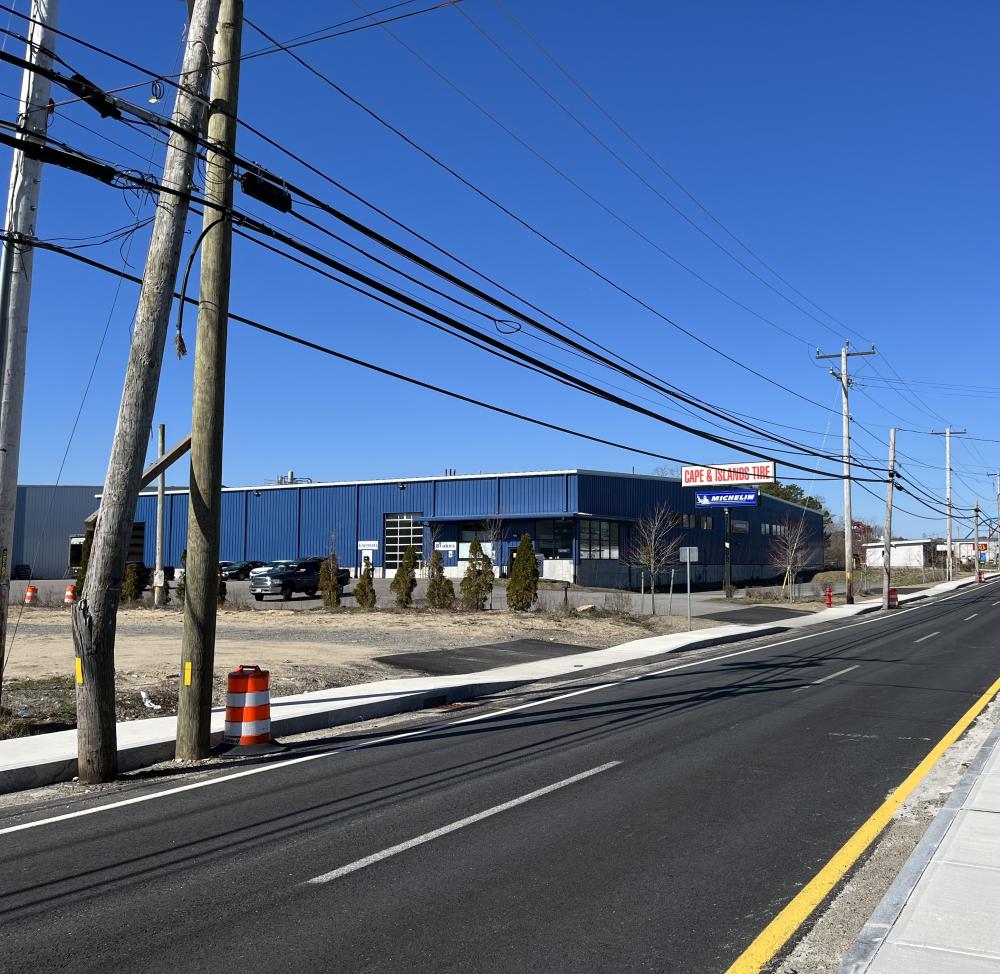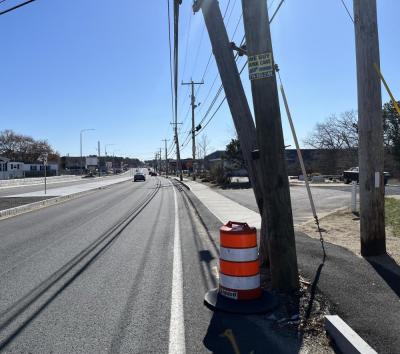Utility poles block final reconstruction work on Cranberry Highway
The majority of reconstruction work on Cranberry Highway in East Wareham is complete. However, utility poles lining the shoulder of the highway – many in the new roadway itself – are preventing final sidewalk, paving and traffic signal work.
The state Department of Transportation expects the project to be completed by the end of 2024, a year later than what was estimated when they presented the project.
Select Board member Alan Slavin, who meets with the Department of Transportation about the project every two weeks, said that Eversource is primarily responsible for the delayed removal of the old poles.
“Utility companies have their control as of right now to remove stuff … as they decide to do it,” Slavin said. “We did get notices that it could be up to two years before [the utility poles] are all moved.”
The $17.4 million project, which began construction in 2021, is designed to make the section of road where Routes 6 and 28 meet safer for traffic and pedestrians. The road has been widened and sidewalks have been added. Pedestrian lights have been installed at crosswalks, but they are not yet operable.
But what may be most evident to those driving the road this spring are the two rows of utility poles: new tall poles on the sidewalk, and the previous shorter poles in the roadway, most with a traffic barrel in front of them.
How much of a traffic hazard do the old poles sticking out of the roadway present? At least one crash involving a utility pole occurred on Saturday, April 8. Wareham Police did not respond to a request for information about the incident, which ended with a pickup truck with a smashed front end being loaded onto a flat-bed trailer. First responders clustered around a damaged pole and the remains of a barrel-shaped caution barrier that had stood in front of that pole.
In a written statement to Wareham Week, Eversource said that moving the utility poles is a collective effort from multiple utility companies, and that electrical equipment needs to be moved last.
“Once those equipment transfers are completed by all of the companies,” the statement read, “we will remove the remaining old poles, which our crews have been doing regularly when equipment is fully removed.”
Slavin said that the Department of Transportation is pushing utility companies to get the job done faster, but there’s not much else that can be done to speed up the process.
Two bills recently introduced in the state legislature would address delayed utility pole movement. Senate Bill 2107 and House Bill 3156 would allow municipalities to move utility poles on their own if a utility company does not do so within 90 days of their work window. Both bills were referred to the Committee on Telecommunications, Utilities and Energy in February, but they have not seen any action since.
State Sen. Marc Pacheco, vice chair of the Telecommunications Committee, said that he sympathizes with municipalities facing delays from utility companies and that delays of this kind are “typical.”
“If it’s not something that’s benefitting what [utility companies] want to take place,” he said, “they don’t move as quickly.”
Pacheco said that he needs to look more closely at the recent legislation, but he agrees that there needs to be a way to expedite the pole-movement process. Pacheco’s office has reached out to utility companies involved with the Cranberry Highway reconstruction and asked them to move quicker, he said.
In a statement to Wareham Week, the Department of Transportation said that Eversource will start to remove the utility poles after Verizon finishes removing its equipment. The Department expects Eversource to begin its work in the middle of 2023 on one eastbound section of the road, beginning from the point where Routes 6 and 28 merge near the Chili’s restaurant and ending at the Water Wizz water park. While that work finishes, Verizon will remove its equipment from a second section of the road, beginning at Water Wizz and ending at to the eastern limit of the project, about 900 feet past Red Brook Road. Eversource would then remove the rest of the utility poles.
The sidewalks next to the existing poles will then need to be finished, and the road needs to receive its final paving, markings and traffic signals. The department said it expects all work to conclude on the project by the end of 2024. A Department spokesperson declined to comment.
Construction on 6 and 28 was originally outlined by the Department of Transportation in 2011, but a contract was not awarded until 2019, to P.A. Landers Inc.
Slavin said the highway’s raised center lane, which prevents drivers from turning wherever they please, was supposed to have round enough curbs for emergency vehicles to drive over. However, P.A. Landers ended up changing the design, which the contract allowed them to do.
Slavin acknowledged that the construction has negatively impacted some businesses along the highway, but said that the safety of drivers on the road is paramount.
“My first choice is public safety,” Slavin said. “We have 150 accidents a year on average on that road, because people take a left hand turn into oncoming traffic.”
















